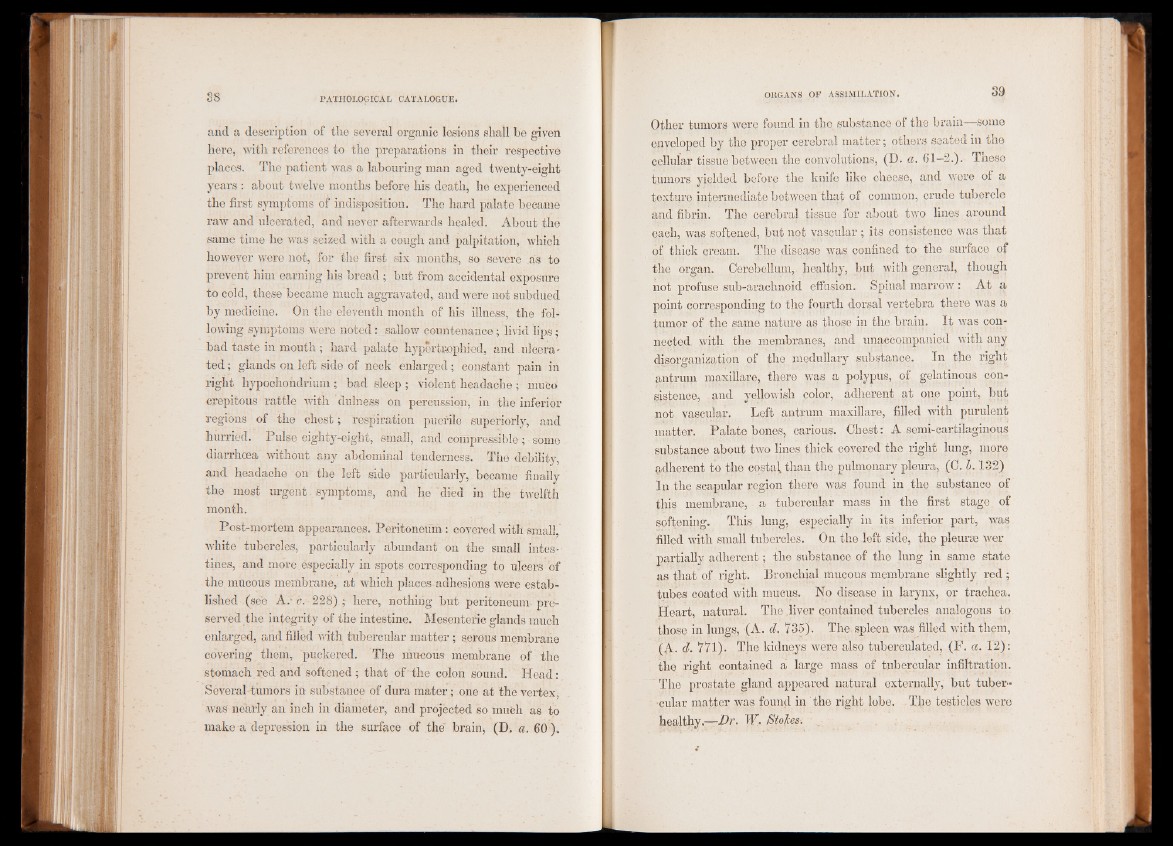
o*5o0
and a description of tlie several organic lesions shall be given
here, with references to the preparations in their respective
places. The patient was a labouring man aged twenty-eight
years : about twelve months before his death, he experienced
the first symptoms of indisposition. The hard palate became
raw and ulcerated, and never afterwards healed. About the
same time he was seized with a cough and palpitation, which
however were not, for the first six months, so severe as to
prevent him earning his bread; but from accidental exposure
to cold, these became much aggravated, and were not subdued
by medicine. On the eleventh month of his illness, the following
symptoms were noted: sallow countenance; livid lips;
bad taste in mouth ; hard palate hypertrophied, and .ulcerated;
glands on left side of neck enlarged; constant pain in
right hypochondrium ; bad sleep ; violent headache ; muco
crepitous rattle with dulness on percussion, in the inferior
regions of the chest ; respiration puerile superiorly, and
hurried. Pulse eighty-eight, small, and compressible ; • some
diarrhoea without any abdominal tenderness. The debility,
and headache on the left side particularly, became finally
the most urgent symptoms, and he died in the twelfth
month.
Post-mortem appearances. Peritoneum: covered with small,
white tubercles, particularly abundant on the small intestines,
and more , especially in spots corresponding to ulcers of
the mucous membrane, at which places adhesions were established
(see A.- c. 228) ; here, nothing but peritoneum preserved
the integrity of the intestine. Mesenteric glands much
enlarged, and filled with tubercular matter; serous membrane
covering them, puckered. The mucous membrane of the
stomach red and softened; that of the colon sound. Head:
Several-tumors in substance of dura mater; one at the vertex
was nearly an inch in diameter, and projected so much as to
make a depression in the surface of the' brainj (D. a. 60 ),
Other tumors were found in the. substance of the brain—some
enveloped by the proper cerebral matter; others seated in the
cellular tissue between the convolutions, (D. a. 61-2.). These
tumors yielded before the knife like cheese, and were of a
texture intermediate between that of common, crude tubercle
and fibrin. The cerebral tissue for about two lines around
each, was softened, but not vascular ; its consistence was that
of thick cream. The disease was confined to the surface of
the organ. Cerebellum, healthy, but with general, though
not profuse sub-arachnoid effusion. Spinal marrow : At a
point corresponding to the fourth dorsal vertebra there was a
tumor of the same nature as those in the brain. It was connected
with the membranes, and unaccompanied with any
disorganization of the medullary substance. In the right
antrum maxillare, there was a polypus, of gelatinous consistence,
and yellowish color, adherent at one point, but
not vascular. Left antrum maxillare, filled with purulent
matter. Palate bones, carious. Chest: A. semi-cartilaginous
substance about two lines thick covered the right lung, more
adherent to the costa\ than the pulmonary pleura, (C. 1.132)
In the scapular region there was found in the substance of
this membrane, a tubercular mass in the first stage of
softening. This lung, especially in its inferior part, was
filled with small tubercles. On the left side, the pleurae wer
partially adherent; the substance of the lung in same state
as that of right. Bronchial mucous membrane slightly red;
tubes coated with mucus. No disease in larynx, or trachea.
Heart, natural. The liver contained tubercles analogous to
those in lungs, (A. d. 735). The. spleen was filled with them,
(A. d. 771). The kidneys were also tuberculated, (F. a. 12):
the right contained a large mass of tubercular infiltration.
The prostate gland appeared natural externally, but tubercular
matter was found in the right lobe. The testicles were
healthy.-—Zb’. W.. Stores.